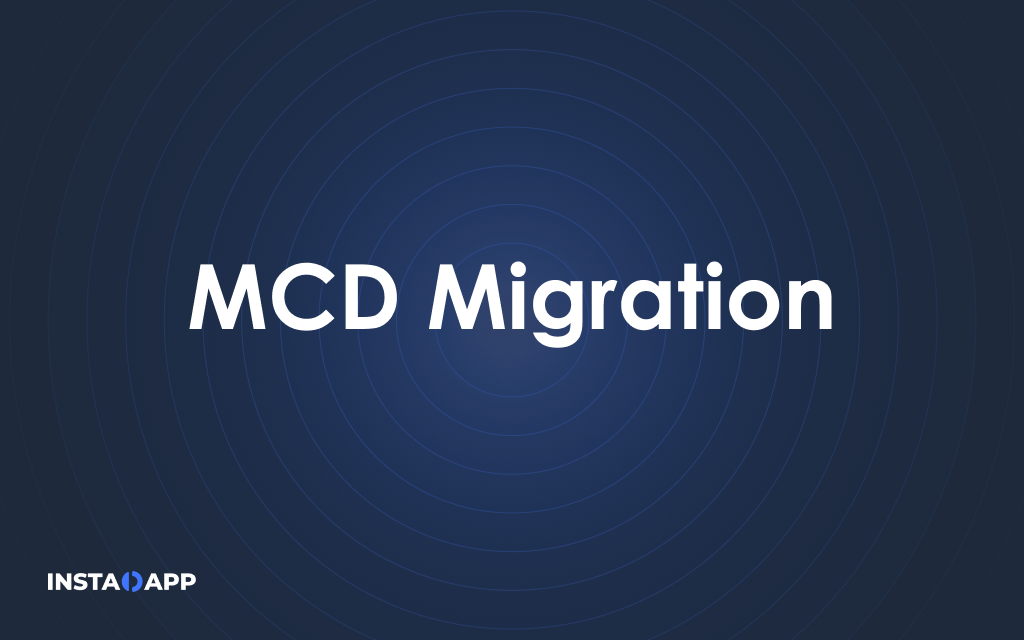MCD Migration for Compound Users and Whale CDPs

InstaDApp’s approach to DeFi has been to proactively understand the critical problems in the space, and work on solving them in a way that’s as trustless and user-friendly as possible.

The migration to Multi Collateral DAI on Nov 18th is one of the most important transitions in the DeFi space thus far. In our opinion, a successful transition will be a strong testament to the resilience and flexibility of the DeFi space, much like how successfully managing the massive volatility in ETH prices earlier this year can be seen as a big confidence boost.
As such, we would like to play our part in helping the ecosystem manage this transition. In our estimation, the most tricky aspects in achieving this transition are: (1) the deep interlocking of DAI in various protocols (particularly Compound), and (2) around the need for sufficient SAI liquidity (Single Collateral Dai) in the markets during the ongoing transition.
In this post, we seek to do the following:
• Articulate our stance on why a successful migration is important for the ecosystem.
• Clarify the difference between the 2 forms of DAI, and where the confusion stems from.
• Explain user-facing and potential systemic problems for Compound users and whale CDP owners.
• Present our approach to solving the user problem and in turn, mitigating the systemic problems.
[NOTE] For users who are just DAI holders or manage smaller CDPs, migration should be easy. They will be able to do the migration either using the InstaDApp or Maker’s site directly. For Compound users and holders of bigger CDPs (or anyone who’s interested), please read on.
Before we begin, note that terminology is a major source of confusion for many users, even seasoned ones, given the fact that many outlets and projects refer to the same things using different terminologies.
Single Collateral DAI — Maker now refers to this as SAI. This is essentially the “old“ DAI, collateralized only with ETH.
Multi Collateral DAI — Maker now refers to this as DAI, as from their point of view, this will be the new default and can be collateralized by multiple tokens. This is also the token that integrates the ‘Dai Savings Rate (DSR)’.
To maximize clarity, we will be referring to Single Collateral Dai as Sai and Multi Collateral Dai as Dai throughout this article.
For Compound Users

Compound Finance is the biggest holder of Sai. Over 34M (25% of Sai supply) is supplied to Compound with over 14M borrowed, resulting in +40% utilization, at the time of writing.
As such, it is important for Compound users to be able to easily migrate over their debt position from SAI to DAI since the market needs to unfold in a manner that Compound SAI borrowers are also paying back their debt with proper alignment. Otherwise, due to the lack of liquidity, the utilization ratio will max out, freezing the overall Compound SAI market. Let’s dive in.
Complications
From the borrower point of view, Compound SAI borrowers have to pay back their initial debt (and again borrow equivalent DAI). Since most debt is borrowed to leverage ETH or other tokens, it is likely they would not have enough capital at hand. As such, they will need to go through a complex multi-step process, which looks like this:
1. Sell off existing token holdings to buy SAI.
2. Wipe SAI debt.
3. Draw DAI debt.
4. Sell DAI to buy the existing token holdings again.
As such, provided the complexity, likely slippage and capital requirements to payback, it could be unattractive for borrowers to collect SAI from the market.
Compounding the problem is that from the lender point of view, existing Sai lenders are likely to withdraw to migrate their SAI to DAI, while potential SAI lenders are also likely to migrate their SAI as well.
When borrowers are not converting their debt position, and lenders are rapidly converting their SAI holdings, this has the potential of maxing out the Compound utilization ratio (which is already very high), and freezing remaining SAI lenders to take any further actions.

To prevent that scenario, it is critical to create a proper equilibrium between SAI lenders and borrowers. The most important factor here is to allow Compound users to bypass the technical complexities, financial hurdles, and capital requirements and make it seamless for them to migrate their debt.
Removing Friction From Compound Migration
In our past experience with the protocol bridge, we have observed how critical removing frictions from capital intensive operations are — within 3 weeks of the launch of our Protocol Bridge, it facilitated the movement of over $40M of ETH between MakerDAO and Compound, and a big part of the success was in allowing positions to be switched seamlessly and trustlessly.
Similarly, we will be launching an InstaDApp Migration Bridge, of which one of the main functions is to allow Compound users to convert their SAI debt to DAI debt in just a single click. This will, in turn, maintain the healthy money circulation between lenders and borrowers, maximizing the chances of a healthy functioning market throughout the whole migration.
For Whale CDP Owners

Whale CDP holders account for the majority supply of SAI. In fact, the top 100 CDPs generated around 80% of the total SAI supply (source).
Complications
In order to migrate CDPs, sufficient liquidity is needed in the migration contract. For smaller CDPs, it’s likely there will be sufficient liquidity. However, assuming minor CDPs keep migrating, the SAI balance in the migration contract will continuously decrease.
Whale CDPs will be prevented from migrating to their CDPs to a Vault, due to the lack of SAI balance in the migration contract available to wipe the CDP debt. The inability of this large CDPs to migrate will mean that the majority of the liquidity and ETH collateral currently used for SAI debt will not be able to move to the MCD system.
Solution: Fractional Migration
The InstaDApp Migration Bridge will allow whale CDP owners to fractionally migrate their CDP to MCD Vaults in just a single click. They don’t need to wait for the migration contract to have an equivalent amount of SAI supply.
For example, if a user is unable to move 100% of their CDP due to the SAI balance of the migration contract, they will be able to partially migrate their CDP up to the value of the SAI balance currently available in the migration contract.
The process is user-controlled action and owners will have to manually migrate each time. This will allow whale CDPs to get their migrations started in a completely trustless manner, without having to wait for the full SAI balance to be available in the migration contract.
At InstaDApp, we work hard on observing the problems that occur across protocols, and to remove the friction points that result from them. We believe that reducing the technical, financial and capital obstacles to operating in this space will be the key to allowing more and more users and capital to enter the wonderful world of DeFi.
As for next steps, we invite everyone to do the following:
• If you own a big CDP, feel free to reach us out via email or text any admin on our Telegram group for personal guidance.
• Reach out to us if you would like to collaborate on anything.
• Discuss this topic with us in our Telegram or Discord channels.
• Last but not least, look out for our announcement on Twitter, post MCD transition, where we will be launching the solutions that we discussed above.
The article is co-authored by Ming and thanks to Anthony, Ryan, Camila, Spencer, and Dan for feedback & edits.
